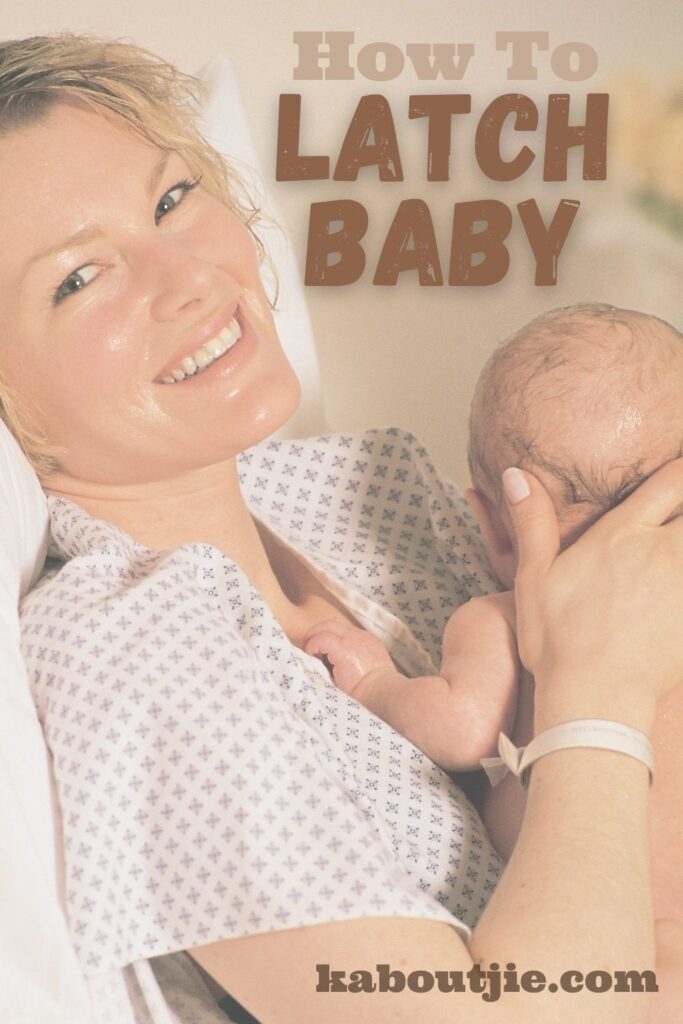Many moms choose to breastfeed their babies rather than formula feed, however breastfeeding is not as easy as it may look and it does not come naturally to a lot of moms. One of the first things that any new moms must master is how to latch baby. A good latch makes all the difference.
***Disclosure -The links in this post may contain affiliate links and I may receive a small commission if you make a purchase after clicking on a link.***

What Does Latch Mean?
A latch refers to the position of your baby’s mouth on your breast while breastfeeding. To latch baby efficiently, his mouth must be wide open, and he must take the areola surrounding your nipple in his mouth as well as the nipple.
Why Is A Good Latch Essential?
There are a few reasons why getting a good latch is essential:
- It ensures your little one is getting enough milk. This includes both the inner fore milk as well as the thicker hind milk that is thicker.
- When your baby is getting enough milk, it also helps control your milk supply, plus your baby is gaining sufficient weight.
- Draining your breasts regularly, prevents issues such as blocked milk ducts, infection, and engorgement.
- It helps prevent sore nipples.
The entire nursing experience will be more relaxed for you both if your baby obtains a good latch from the start. We are here to help. If you want to know more about how to get baby to latch properly, keep reading.
6 Guidelines – How To Latch Baby Correctly
Getting the most comfortable latching position
Before you begin, no matter which nursing position you chose, ensure that your baby’s neck, head, and spine are aligned and not twisted. His chin must be up and not lowered towards his chest. You must also feel comfortable. Prop up some cushions or pillows to support your baby, your arms and back.
Prompt baby to open his mouth
Bring your baby close until your nipple is at the same level as his nose. Gently tickle his upper lip with your nipple to get him to open his mouth. The wider he opens his mouth, the better since it will encourage a perfect latch.
Bring him to the breast
Once his mouth is wide open and his tongue is positioned over his bottom gum, put him on your breast with your nipple facing the top of his mouth. His chin must touch your breast first. This way he can take a large part of the areola (area surrounding your nipple) in his mouth. His jaw and bottom lip must cover a substantial amount of the area underneath your areola. It helps to shape your breast while you are bringing him closer to feed. Not every position is ideal for moms, therefore feel free to experiment to see what works best for you both.
Baby must remain close while he is latched on
Not all mums have the same breast shapes or nipple positions, therefore your latch may not be considered textbook. Your baby must remain close while latched on with his chin touching your breast. Newborn’s noses must be turned up because it helps them with breathing comfortably while latched on. It also assists with coordinating sucking and relaxed breathing.

Keep listening and watching
When your baby feeds, your nipple must be positioned against the roof of his little mouth with his tongue gently cupped underneath. A good latch does not feel painful or uncomfortable. It feels like gentle tugging. Keep watching your baby while nursing.
Initially, he will do quick, rapid sucks that stimulate milk flow, also referred to as let-down reflex. Once the milk begins flowing, he will start sucking more deeply and slower with pauses in between. This is generally a good sign that he is getting milk. His jaw will be moving, and you will hear sucking and swallowing sounds when he feeds.
Another sign to look for is that your baby produces plenty of dirty and wet nappies which means he is gaining the expected weight through feeding.
How to gently break the latch
If the latch is painful and shallow, or he begins biting on your nipple, or he brushes the end of your nipple with his tongue, you must break the latch and try again. Gently ease your finger inside the corner of his mouth to interrupt the suction.
Signs That Indicate A Good Latch
Certain signs that indicate a good latch include:
- The latch does not feel painful and is comfortable for you both.
- His tummy and chest are resting against your body with his head in a straight position, and not turning to the side.
- His chin is touching your breast.
- His mouth is wide open and cupped around your breast, not only the nipple.
- His lips are turned out.
- His tongue is cupping under the breast.
- You notice and hear swallowing.
- His ears are moving slightly.
What to do if you are struggling to get the perfect latch
- Go to a serene and quiet space.
- Hold your little one against you, skin to skin. While both of you are undressed, hold him against your chest.
- Allow him to take the lead while you support his neck, while using your hands to support his shoulders, neck, and hips.
- Offer the breast to him but let him locate the nipple himself.
- If you are still having issues, speak to a local lactation expert to assist you.

4 Recommended Positions For Getting The Perfect Latch
The football hold
The football hold is often a preferred choice for mums who had a caesarean birth since it protects the incision while offering better support for your baby’s neck and head while feeding. This hold is also a good fit for mums with larger breasts and tiny babies, or twins. Positioning and supporting your baby is more comfortable with the football hold.
- Support baby’s head by positioning your thumb and fingers underneath baby’s ears and around the nape of his neck.
- Tuck him underneath your arm and place him so that his chin, chest, and knees are facing your breast.
- A pillow can be put next to you to position him higher.
Lying side by side
The lying side to side position is a perfect choice for night time feeds and moms who had caesarean births.
- Position bay on his side with his chin, chest, and knees facing your breast.
- Support his head and back with your arm and hand.
Cross cradling
With cross cradling, it is easier to support baby’s head. With this position you can drape him across your chest to feed.
- Support his head using your thumb and fingers underneath his ears and around the nape of his neck.
- Turn him on his side with his chin, chest, and knees facing the breast.
- Wrap him across your chest and if necessary, use a pillow to support him so that he is level with your breast for easy access.
Cradling
For most mums, the cradling position is the most well-known one. Even though it is used commonly, it is not always the most effective since mums have less control over baby’s head.
- Place his head where your elbow bends.
- Position him on his side so that his chin, chest, and knees are facing the breast.
- Use your arm to support his back and bottom.

5 Reasons Why Baby Refuses To Latch
There may be various reasons why your baby refuses your breast. The best way to peak your little one’s interest into staying positive and ensuring he is getting the necessary nutrients and calories he needs while figuring it what the problem is, is to maintain a special bond with him and prevent each interaction to be a feeding issue.
Baby has not yet figured out what to do
While milk production is natural, nursing is one of those skills that both mums and babies must learn.
The position you have chosen is not comfortable for him
Make sure that your little one’s head and chest are always facing your breast. Bear in mind that even though he has accepted a certain nursing position before, he may not feel comfortable now due to underlying issues you do not know about. For instance, an ear infection could make lying in a certain position painful. Try switching positions to see if he feels more comfortable and start nursing.
He might have a physical reason for not taking the breast
In one instance a mom took her baby who refused to latch the entire day to her pediatrician. They discovered a tiny piece of plastic lodged into her gumline. Once it was removed; baby was taking the breast again. Always examine his mouth thoroughly to see if everything is ok.
He might experience nipple confusion
Nursing babies use various swallowing and feeding skills than those who are bottle fed. When a nursing baby is given artificial nipples prior to his nursing skills being fully developed, he might be experiencing nipple confusion.
He is on a breastfeeding strike
A breastfeeding strike refers to a baby who has been nursing incredibly well for weeks or even months and then suddenly refuses to nurse. It can last for a few feeds or days. In some cases, the cause is easily identified, while at other times, the cause could not be found. Nursing strikes rarely result in weaning.

Strategies To Get Baby To Latch
Skin to skin care
Skin to skin care is incredibly useful to give your baby a sense of closeness to you. This is also called kangaroo care and entails you holding your baby against your bare chest with him only dressed in his nappy. Skin to skin often coaxes baby into finding the breast on his own and latching on. A reclining position might assist. Drape a blanket over you and him, if necessary. This closeness with your baby will stimulate your body to release prolactin (milk generating hormone) to keep up with milk supply during your baby’s non-breastfeeding stage.
Check for baby’s hunger cues
When you notice early signs of hunger, offer your breast. You might also make use of some form of co sleeping because babies are more receptive when they are in a light sleep (drowsy or scarcely awake). Try not to wait when baby cries for his next feed. When baby is too hungry, he might have difficulty getting a good latch or an effective feed.
Take a bath with him
Many babies find it more comfortable to latch on in a shallow lukewarm water bath. The water has a relaxing and soothing effect on both you and him. Just remember to keep tabs of the amount of bath water and do not bath with him if you feel sleepy.
Keep maintaining your milk supply
It often helps to massage your breast before attempting to latch your baby because it will stimulate let-down and lower the amount of effort he must expend before your milk starts flowing. Breast massaging is great for increasing milk supply. You can also use a breast pump to boost milk supply and coax your baby back to your breast.
Enlist the aid of a professional lactation expert
Some conditions such as inverted or flat nipples make it more challenging for moms to get a good latch and breastfeed successfully. A skilled lactation expert can help with identifying the best solution for your individual issue.
BONUS: Foods that will help increase your milk supply
There are natural ways that you can try for increasing your milk supply and one of them is to include certain galactagogues into you diet. These are foods like flaxseed, oats and brewer’s yeast that are known for boosting milk supply. Most lactation cookie recipes include these ingredients. Here is more information about why these foods are a good option for breastfeeding mums.
Oats – Particularly good old rolled oats are packed with iron. Low iron is not conducive towards healthy breastmilk supply.
Brewer’s yeast – This is not the same as baker’s yeast. Brewer’s yeast contains zinc, potassium, iron, vitamin B, and magnesium. All these ingredients are good for increasing milk supply.
Flaxseed – Are packed with phytoestrogens and omega-3 fatty acids which are beneficial for both mom and baby.
Barley – An excellent source of beta-glucan. This ingredient increases prolactin which is the primary hormone your body requires to generate breastmilk.
Conclusion
We hope you have found this article informative and will use it as a useful guide in your quest of getting baby to latch on and breastfeed successfully.
 Kaboutjie SA Mommy Blogs by Lynne Huysamen
Kaboutjie SA Mommy Blogs by Lynne Huysamen




I’m breastfeeding baby 3 now. No matter what, there is always worry that im not doing things properly. Verrrry helpful info, thanks.
Congratulations Mommy,I just wanted to say that I completely agree with you
As a mom to be in a few months this information is very helpful, one can never stop learning thank you.
My son is 18 months and still breastfeeding can’t get him off
I’m a first time mom to be. At times i am scared of whats to come. But reading this article gave me some peace of mind.
Unfortunately I never got my son to latch & expressed for the first 4 months. Yes breast milk is the best, but it is not the only means & ways to feed your baby. As long as you are feeding your baby you are doing a good job… having a baby (especially your first) isn’t always easy, but there are many happy moments that out weigh the hard ones. Do what works for you
I wish I was able to breastfeed my babies. But after 2 weeks my milk dried up completely. I tried yeast pills and a mixture that cost me R100 a day. I was unable to afford the mixture after the 4th day. I resorted to formula. If I was able to I would have breastfed till they were 2 yrs of age.
I am new to this page,but have already learned so much. Thank you all and God bless you
Great advice, it’s well worth it to spend the extra time researching and practicing to perfect the baby’s latch. You’ll know when it’s right and after that breast feeding is an absolute joy.
My daughter only breastfed for 3 months because I didn’t have any milk😭 I tried everything to increase my breast milk supply but nothing worked.
I had the best time of my life breastfeeding my baby
I wish my baby latched. My mipples were inverted, my milk supply was extremely low… but she’s a healthy 3 year old girl now.
I will definitely be using all these tips for my bubs on the way. I failed the first time around as I was not prepared to breastfeed.
Nicole I also struggled to breastfeed my first baby, it really is so hard! With my second I managed to exclusively breastfeed until 13 months. I wish you success the second time around.
I’ll be a first time mom and few short months and this information is very informative! Thank you!
Very informative, no baby yet but at least I’m learning to have an idea of what’s to come and how to handle it
Very insightful!
A must read for expecting moms!